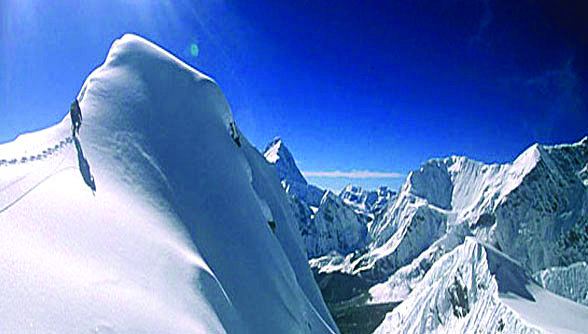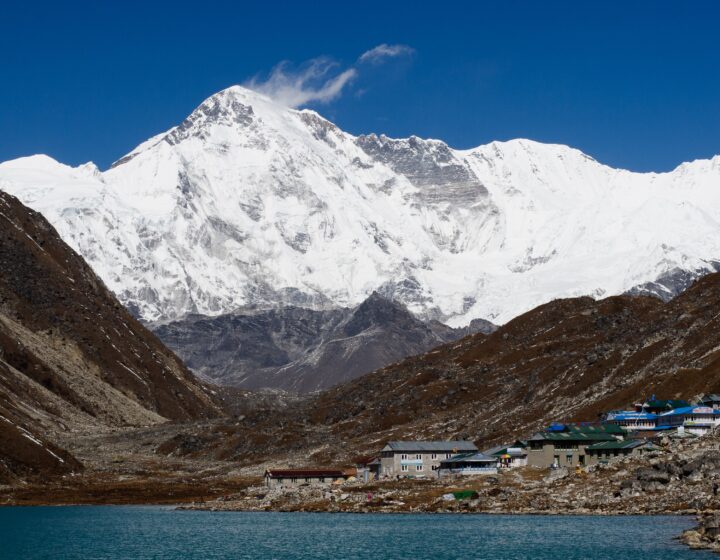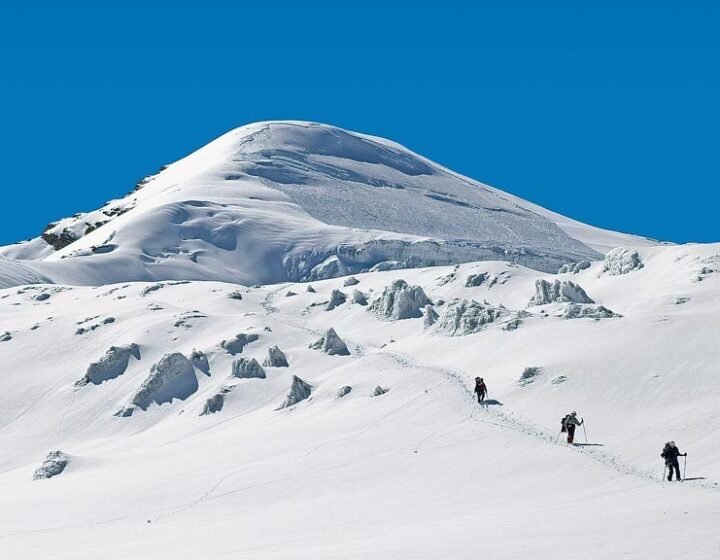- Details
Detailed itinerary
Itinerary- Tour Includes/Excludes
- Useful Info
- Trip Map
- FAQ
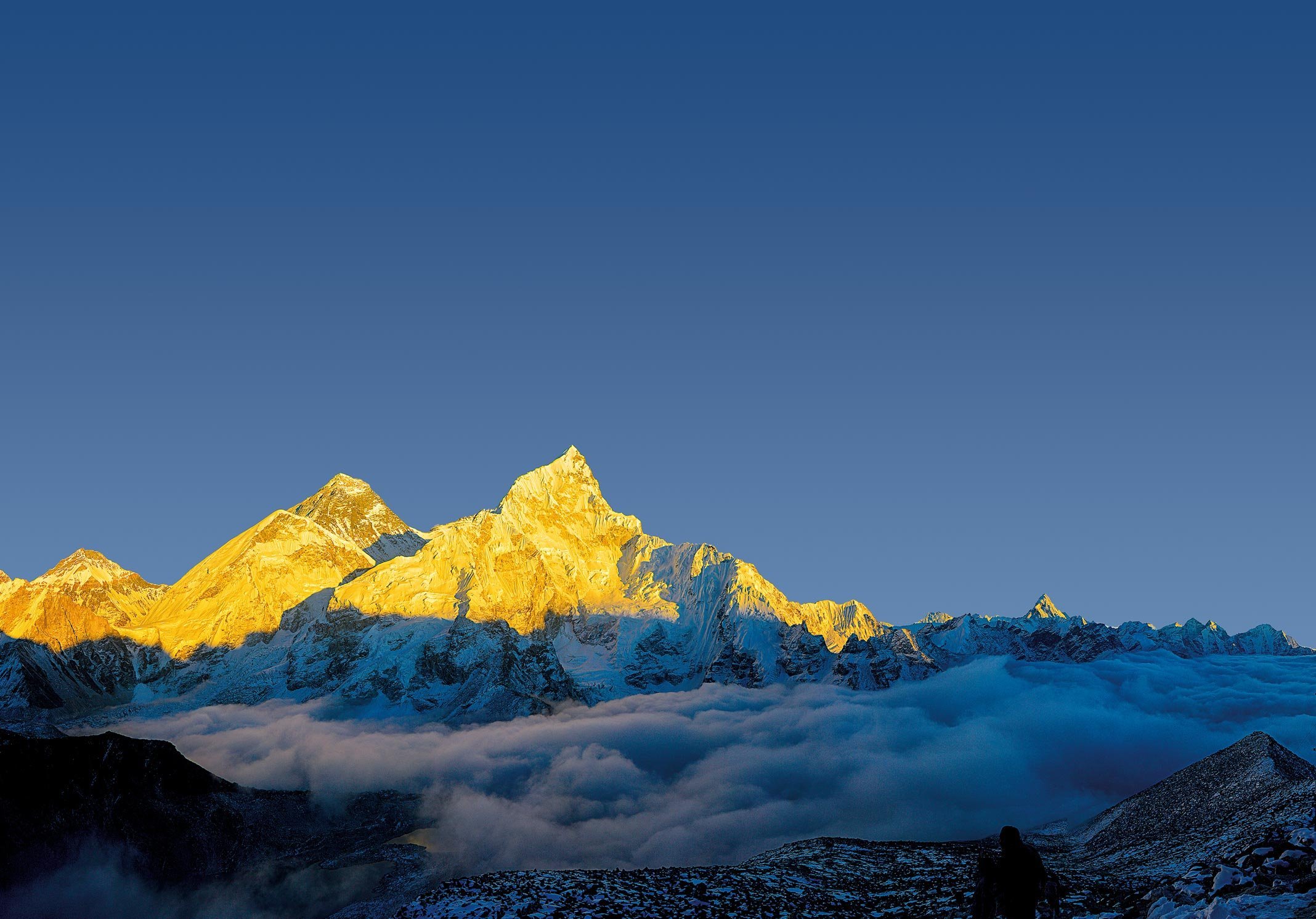
Trip overview
The Mount Everest Expedition is one of the world’s most challenging physical and mental undertakings. Joining the ascent of Mount Everest gives you a tremendous sense of pride and lets you feel like the most daring person on earth. On May 29, 1953, Edmund Hillary and Tenzing Norgay became the first to successfully summit Everest and became the world’s greatest adventure climbing heroes. Since then, several people have successfully led and ascended Mount Everest. Without any doubt, Climbing Everest is the greatest challenge.
Climbing Strategy for Mt. Everest Expedition
We established a permanent expedition base camp for the duration of the climb. Every member of the climbing crew has their own tent, as well as kitchen and storage tents. There we provide a large dining hall with chairs and tables that is carpeted, heated, and lit by solar electricity to make your stay comfortable. The camp is set with internet facilities also. We offer a shower tent and a toilet tent, both of which are kept clean. At base camp, we have an experienced expedition cook to prepare delicious meals and a team manager to handle all the logistics for a successful expedition.
On our acclimatization hike to Camps 2 and 3, we climbed the Khumbu Icefall several times. We went back to base camp to rest and recover before attempting the summit. After receiving confirmation of a positive weather forecast, we proceed to ABC, then CAMP 1, CAMP 2, CAMP 3, CAMP 4, and finally, the SUMMIT. Our professional Sherpas finish their preparations by ensuring that all high camps have enough tents, food, and oxygen for the summit push. All of the higher camps have tents. There will be a one-to-one climbing Sherpa ratio to ensure that every climber receives complete support to reach the summit and safely return to base camp.
A Guide to Climbing, Safety, Communication, and Weather
Our Climbing Sherpa crew is one of the best since they have extensive expertise in delivering the best high-altitude climbing support. They are unrivaled, evidenced by their track record of many successful Everest summits. All of our Mount Everest climbing sherpas have considerable outdoor medical training and can deal with common medical conditions. As a safety backup, we have oxygen, extensive medical supplies, and a Gamow bag. We also encourage all climbers to bring their personal micro-medical kits. All Everest excursions require good weather to ensure the safety of our climbers and support team. For the entire climbing, we have managed a professional and reliable weather forecast service, which provides continuous information and updates until the final summit.
Highlights
- The world’s highest peak is Mt. Sagarmatha.
- The sunrise from Kalapathar.
- An exciting alpine flight from Lukla with panoramic Himalayan views
- Trekking through rhododendron and oak woodlands and alpine forests
- Sherpa villages’ and their rich cultural heritage.
Itinerary
Day 1: Arrive in Kathmandu O/n at the hotel.Your Everest Expedition begins when you arrive in Kathmandu. On your arrival at the airport, one of your agents will meet you and transport you to the hotel. In Kathmandu, spend the night.
The day starts with a warm breakfast. Meanwhile, we'll start working on getting the expedition's permits. Climbing Everest necessitates payment of a royalty to the Nepalese government. and after that you can spend your time enjoying Kathmandu cultural heritage.
The day starts with a warm breakfast. You will meet your excursion team members, staff, and guides. They will brief you on overall climbing information such as climb time, preparation, camping, trekking gear, death zone, and so on. You'll also go over the highlights of South Carolina or the classic Everest trail. You can then rent or buy the essential climbing gear and equipment. In Kathmandu, spend the night.
The day starts early as you check out of the hotel and drive to the airport. From Kathmandu, take a 30-minute flight to Lukla. The flight provides a tranquil view of the neighboring mountains and beautiful forested hills. You'll have breakfast at one of the restaurants when you arrive. Today marks the start of the journey. After leaving Lukla, start hiking upstream along the Dudh Koshi River towards the Phakding settlement. Phakding overnight.
The seven-day hike takes you past picturesque Sherpa villages. Begin your hike upstream along the Dudh Koshi River, leaving Phakding village on your way to Monjo. When you enter Sagarmatha National Park, you'll begin your ascent through Jhorsalle to Namche Bazaar, the main settlement in the Khumbu valley.
The trail begins in Pangboche and continues along the Imja River to Dingboche. Continue uphill towards Tengboche Monastery, overlooking the stunning Ama Dablam Peak. A quick tour provides an insight into the monastery's century-long history. Continue walking towards Lobuche via the old Mani Walls.
You'll acclimate at Everest Base Camp for a few days before beginning the climb. The trek climbs north along the pristine Khumbu Glacier to Gorakshep. Gorakshep is located halfway between Kala Patthar and Everest Base Camp. Everest Base Camp is reached after a 2-3 hour climb along the Khumbu Glacier. Lhotse Peak can be seen from the boulder-strewn base camp.
Acclimatize for a few days at the base camp. You must become acquainted with the local weather, altitude, and temperature so your body and mind can focus on your climbing. During this time, you will have the opportunity to interact with your teammates, staff, and guide.
Your liaison officer will ensure that everything runs smoothly at the base camp. We will offer you a separate kitchen, restroom, and meals throughout your stay. You can also use satellite phone service to communicate, Wi-Fi, internet hotspots, and a warm shower (a cost will be incurred). Spend the night inside the tent.
After acclimatization at the base camp, you'll start preparing for the considerable ascent. Your Sherpa guide will teach you to cross crevasses, climb ladders, and utilize the fixed rope, harness, carabiner, and ice axe. You will train with your guide and teammates before beginning the ascent. Spend a couple of days climbing up and down Camp I to acclimate properly.
Begin by crossing the Khumbu Icefall, the most challenging part of the climb. The brittle ice part frequently makes progress difficult. A short ascent via the icefall leads to Camp I, also known as Advance Base Camp. Begin climbing through the snow along the Lhotse Wall towards Camp II (6500m) after leaving Camp I. Climb across snow crevasses until you reach the Western Crown. Camp III is reached after a nearly 8-hour arduous trek through the snow (7470 m). During the ascent, it is typical to experience "Khumbu cough." Keep an eye out for low oxygen levels and stay hydrated.
After leaving Camp III, you'll begin your ascent through the Geneva Spur and Yellow Band to Camp IV (7920 m). You'll be approaching the danger zone from Camp IV. Camp IV, located just below the danger zone, serves as the summit's launchpad. Begin climbing the ledge that runs along the steep ridge and continue uphill until the Hillary Step. The ascent can take up to 9 hours and includes the intricate "Balcony."
Only one person can cross the Hillary step at a time in one of the most challenging portions. After crossing the stage, you'll begin climbing the final ridge to the summit. When you reach the summit, you may take in the breathtaking scenery of the mountains, glaciated valleys, and Tibetan plateau. After some time at the top, you'll start descending. Retrace your steps and continue down to the base camp through the various centers.
You'll start heading down once the base camp has been cleared. Retrace your steps and start the descent to Gorakshep. After leaving Gorakshep, the trail starts to descend along the Khumbu Glacier before passing through the settlement of Lobuche and coming to Dingboche. You'll gradually pass through typical Sherpa communities on the way to Lukla.
To get to Pangboche, the trail continues down the Imja Khola downstream before crossing Debuche. Before descending to the Tengboche monastery, explore the lovely Pangboche Monastery. The trail continues as it passes by the beautiful Ama Dablam and into the Dudh Koshi Valley. You can reach Namche Bazaar by taking a beautiful hike through Phungi Thenga. As you descend the slope toward Jhorsalle, keep taking in the magnificent view of Kongde Ri Peak.
After leaving Sagarmatha National Park, you must descend to Phakding from Monjo. You can join your teammates in toasting the voyage's success when you get there. The trek gives up after completing the two-hour trip back to Lukla. Spend the night at Lukla.
From Lukla, take an early-morning flight to Kathmandu. In general, the morning continues to be precise. As a result, you'll board the first available flight to Kathmandu. You'll return to the hotel and have breakfast when you get to Kathmandu. Kathmandu: overnight and a day of rest
The last day in Kathmandu is today. You will tell your team members and Sherpa guide farewell after breakfast and drive to the airport to catch your journey home.
Included
- Transportation to the airport.
- 06 nights of B/B hotel accommodations in Kathmandu.
- All domestic flights include the airport fee.
- Everest Summiteers with Sherpa Climbing (01 Sherpa: 01 Climber).
- Taxes levied by the government and the Everest Expedition summit permission charge.
- Entrance fees for national parks.
- Route costs for the Khumbu Icefall.
- While trekking to base camp, the liaison officer received a full-board, high-altitude meal plan with all his expenses covered by the climber's fee.
- Knowledgeable climbing instructors and porters with their gear, daily pay, food, and insurance Cook, cook assistant, manager, and leader of the base camp.
- In addition to base camp tents, dining tents with tables and chairs, kitchens with all essential supplies, and toilets with commodes are provided.
- High Altitude Sherpa tent and New Member.
- All required Everest climbing hardware group gear.
- Emergency satellite phone service.
Not Included
- Any form of personal and medical insurance.
- Airfare outside of Nepal and entrance visa costs
- Kathmandu's major dinner.
- Personal gear for expeditions and climbing gear.
- Tips, summit bonuses, and personal expenses of any form not specified in the cost as mentioned earlier of climbing Everest
Useful Info
- Carry the necessary hiking equipment.
- Carry light snacks with you to balance your energy and blood sugar levels, such as muesli, chocolates, chips, and nuts.
- Keep yourself hydrated and speed up your metabolism.
- Possess the necessary physical conditioning to perform small ascents and descents
- Do not rush, and maintain your composure as you hike.
- To learn more about the location, follow the directions of the guides.
- To have a successful trek, adhere to the laws and regulations.
- Avoid alcohol as much as possible, although, for certain alcohol regular trekkers, a few pegs are allowed to keep your senses intact.
- Take good care of your health because issues like asthma, vertigo, avalanches, and altitude sickness can occur.
- Note the best times of year for extraordinary experiences.
Trip Map
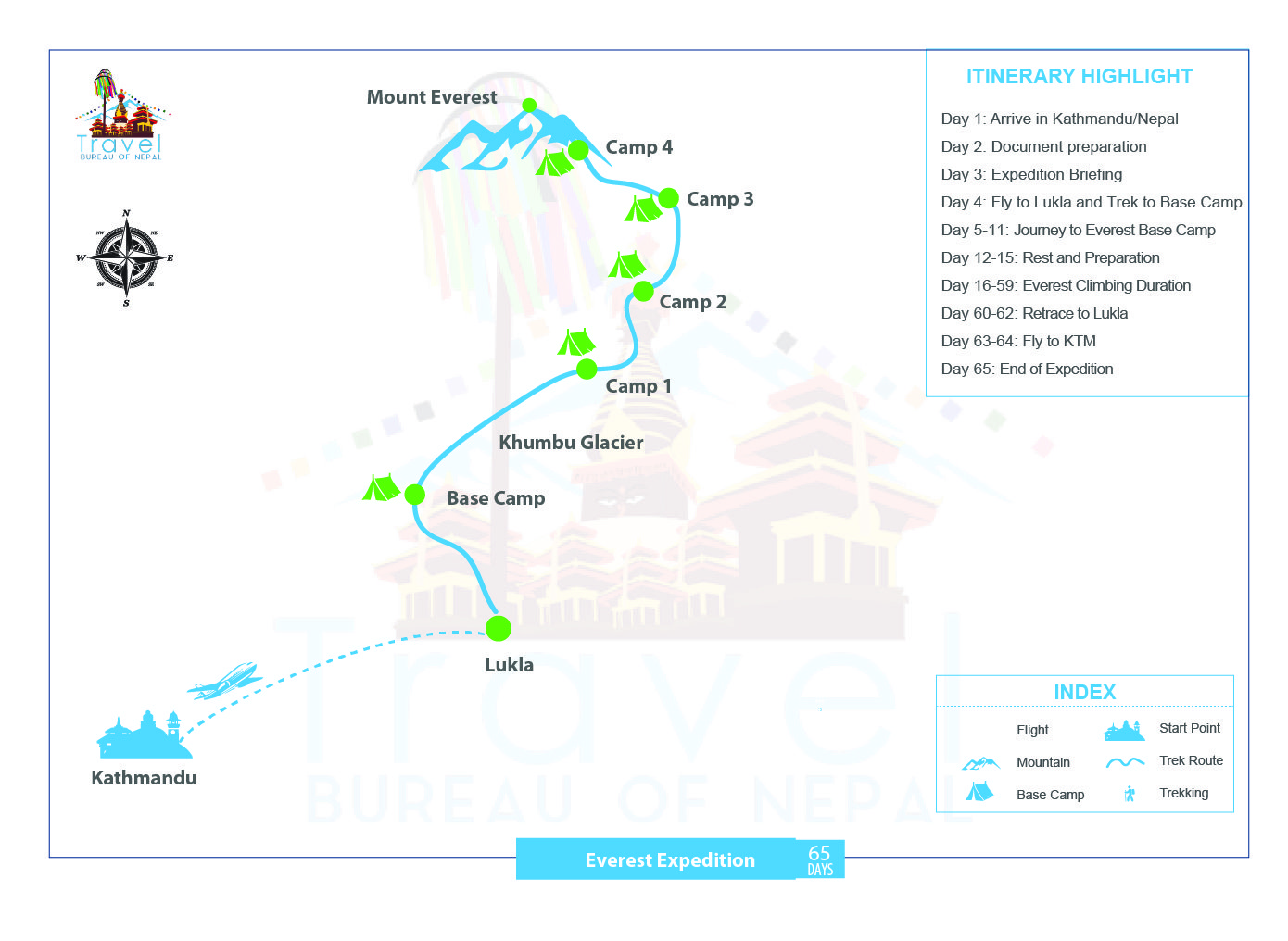
FAQs
-
Why does climbing Everest take two months?
The three main elements affecting the Everest climb's length are acclimatization, weather, and the hike. If the conditions are right, the trek can be skipped by taking a costly helicopter from Lukla to Base Camp. If not, it will require 8 to 14 days to complete the walk, depending on rest and acclimatization.
-
How do I prepare for the Everest expedition?
Assuming you are healthy and free from injuries, prioritize your training efforts as follows: Pack-loaded uphill hiking, strolling, and stair climbing are all forms of climbing conditioning. Exercises that strengthen the lower body and the core Activities for the heart, such as aerobic and anaerobic sessions with and without load, Flexibility exercises
-
What type of weather may be expected throughout the trek?
The weather in the Himalayas is difficult to forecast. But it will undoubtedly be colder and more difficult. You will be advised on how to prepare for the walk.

